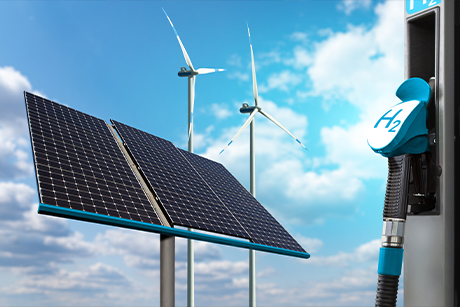NEWS & INSIGHTS | Opinion
6 key UK clean energy research priorities driving the net zero mission

This week in net zero: Energy Transition Outlook 2025, Clean Energy Superpower Research Priorities, Global Electricity Mid-Year Insights 2025
Chief Technology Officer at NZTC, Luca Corradi, and his team closely monitor the global net zero landscape. They follow the trends, policies, investments and technological innovations that, together, bring the world closer to its shared climate goals. Learn more about our horizon scanning service. This week, Luca and his team look DNV’s forecast for global energy supply, key research priorities for the Clean Energy Superpower Mission, and explore changes in global electricity generation.
Renewables to lead global energy supply by 2060, DNV forecasts
The Energy Transition Outlook provides forecasts through to 2060, spotlighting major regional energy developments.
DNV projects that global CO₂e emissions will decline by 43% by 2050 and 63% by 2060, with net-zero emissions not expected until after 2090. A drop in energy-related emissions is anticipated from 2026, driven by:
- Rapid growth in renewable energy
- Efficiency gains, especially through electrification
- Progress in CO₂ capture and removal technologies
By 2060, solar and wind are expected to supply over one-third of global primary energy, a sharp rise from just 3% today. In contrast, fossil fuels are forecast to fall from 80% to 36% of the primary energy mix.
Electricity demand is set to more than double, from 32 petawatt-hour per year in 2024 to 77 petawatt-hour per year by 2060, increasing its share of global energy demand from 21% to 43%. This surge is driven by:
- Greater electricity use in buildings, especially data centres
- Accelerated electrification of transport and industry
Data centre energy use will grow fivefold by 2040, accounting for 5% of global electricity demand – 3% from AI and 2% from general-purpose computing. Regional differences are significant, with North American data centres projected to consume 16% of the region’s electricity.
By 2060, solar and wind will dominate electricity generation across all regions, contributing 47% and 32% respectively. Meanwhile, the share of fossil fuels in electricity generation will plummet from 59% in 2024 to just 4%. Nuclear energy will make up 9%, nearly 150% growth from today, driven by rising energy security concerns.

Primary energy supply
Credit: DNVt
UK sets clean energy research priorities to achieve net zero by 2050
DESNZ outlines key research priorities for the Clean Energy Superpower Mission (CESM).
Paul Monks is calling on academia, industry and the public sector to collaborate on the challenges and opportunities identified in the newly published Areas of Research Interest (ARI) for the Clean Energy Superpower Mission. This document sets out the critical research and innovation areas needed to deliver clean power by 2030 and reach net zero by 2050.
The research themes span six key sectors:
- Energy system infrastructure
- Integration and flexibility
- Power generation
- Industry
- Transport
Research & Development Priorities Include:
- Scaling up low-carbon hydrogen production: Focused on cost-effective methods, integrating large-scale electrolysis with variable renewables and exploring negative emissions hydrogen technologies
- Carbon removal technologies: Advancing solutions to directly remove greenhouse gases (GHGs) from the air or sea
- Next-generation wind turbines: Developing advanced onshore and offshore turbines, including floating offshore wind (FOW) technologies for deep-water sites (50m+)
- Boosting UK manufacturing for FOW: Addressing innovation challenges such as foundation design to strengthen domestic capabilities
- Leveraging digital and AI solutions: Mobilising data and digital tools to support net zero, enable cross-sector integration, and improve systems-level understanding
- Reducing offshore oil and gas emissions: Creating cost-effective solutions and improving monitoring, reporting, and verification methods
The Net Zero Technology Centre (NZTC) is actively addressing several of these priorities, reinforcing the importance of its work in supporting the UK’s clean power goals for 2030 and net zero ambitions by 2050.

Clean Energy Superpower Mission structure
Credit: DESNZ
Solar and wind surpass coal in global power generation
In the first half of 2025, global electricity demand grew by 2.6%. However, the surge in solar and wind generation outpaced this growth, marking a historic moment: renewables overtook coal in the global electricity mix for the first time.
- Solar energy led the way, meeting 83% of the demand growth, with output rising by 306 TWh (a 31% increase).
- Wind generation also grew, adding 97 TWh (up 7.7%).
- Overall, renewables expanded by 7.7%, while coal generation declined by 0.6%.
Regional trends
In China and India, fossil fuel generation declined as clean energy growth outpaced rising demand. In contrast, EU emissions increased by 13 MtCO₂ (up 4.8%). Despite strong solar growth, shortfalls in wind, hydro, and bioenergy led to greater reliance on gas and coal.
Other energy sources
Hydro generation dipped slightly worldwide, with a 17% drop in the EU due to droughts and heatwaves. Nuclear generation rose by 2.5%, with further growth expected as more countries plan to build new reactors or extend the life of existing ones.

Growth in solar and wind generation outpaced the rise in global electricity demand in H1-2025
Credit: EMBER
Subscribe for the latest updates





